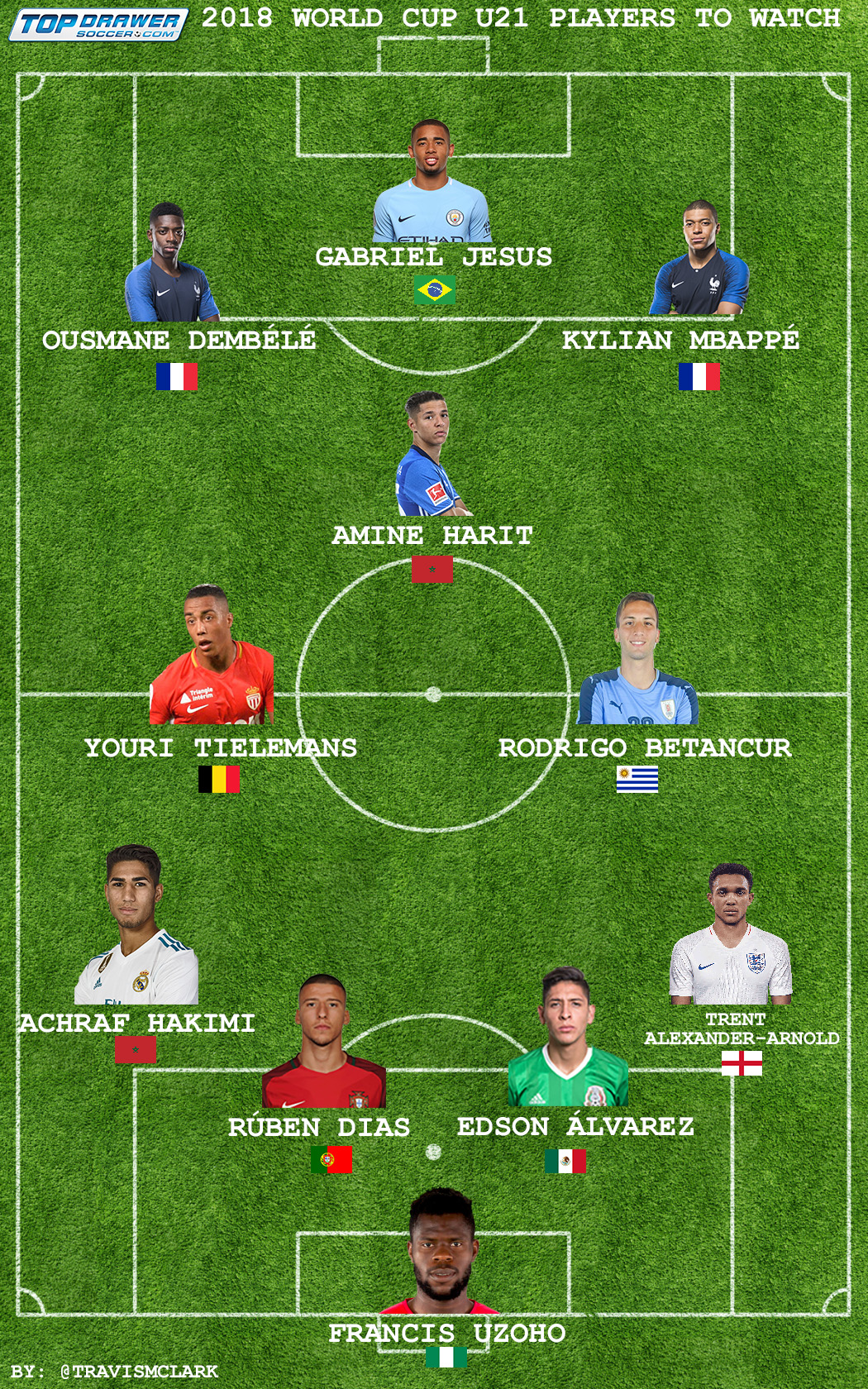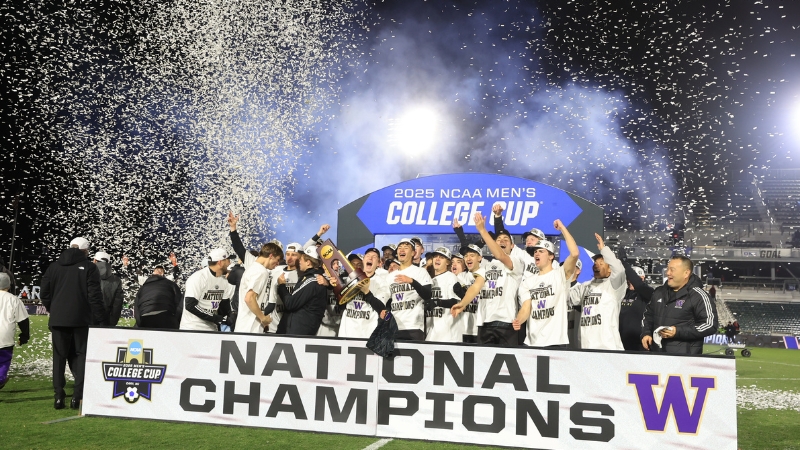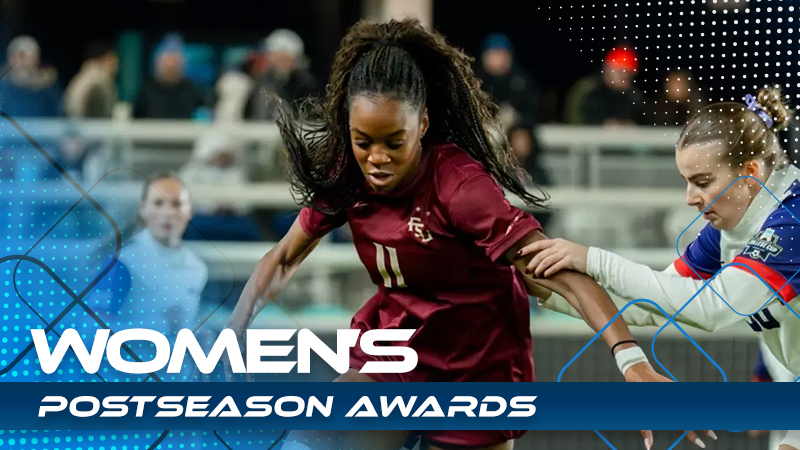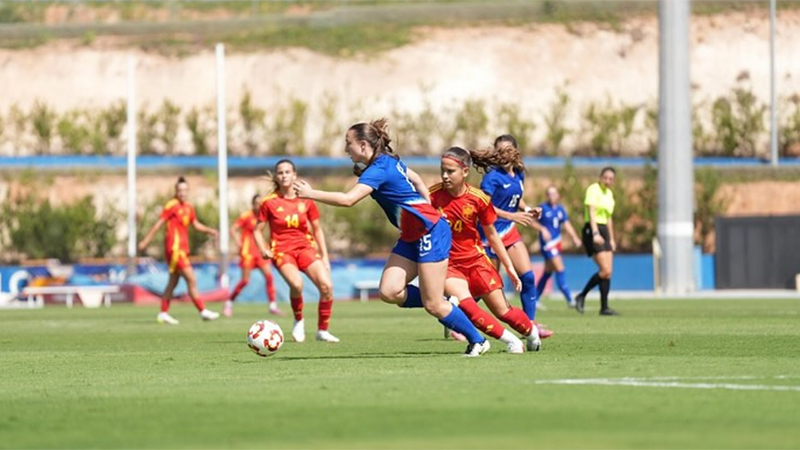U21 players to watch at the World Cup
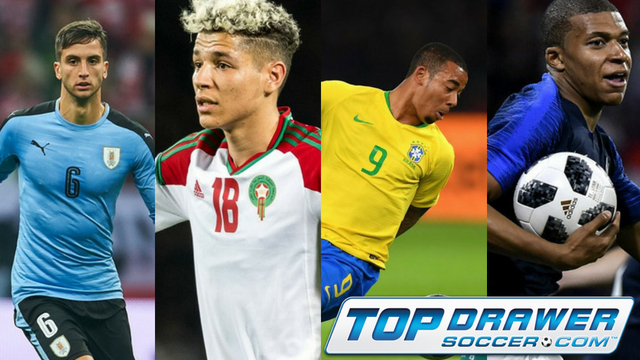
While the U.S. Men’s National Team is obviously set to miss this year’s World Cup, that’s no excuse not to watch.
There is ample cadre of young players set to make an impression. For the purposes of this article, we’ve set the cut off at 1997, compiling a roundup of some of the best U21 players on squads heading to Russia. In all, 21 players born in 1997, nine players born in 1998 and one player born in 1999 were named to their respective squads.
Along with the above graphic, below is a look at some of the top players to know heading into the 2018 World Cup.
Goalkeepers
Not surprisingly, goalkeeper is the one position that lacks players born in 1997 or later. However, there’s a chance that Nigeria trots out a 19-year-old as its starting goalkeeper. Francis Uzoho earned the start in three warmup friendlies against DR Congo, England and the Czech Republic. It’s an interesting move from head coach Gernot Rohr, as Uzoho plays for Depor Fabril in the third division of Spain. Physically, he looks up to the task, though the experience factor could see him relegated to the bench.
Defenders
Like goalkeepers, most managers hesitate to rely on young back lines at a World Cup. That’s not to say there aren’t any candidates. Trent Alexander-Arnold’s breakout club season at Liverpool has him poised to at least get a sniff of a chance for England as they seek progress from Group G.
Another promising young outside back is Ashraf Hakimi. On the books at Real Madrid, Hakimi has 10 caps for Morocco, and can play as a left back or right back for the national team (though he’s plays typically on the right for Real Madrid). Keep an eye on Morocco and Hakimi, both of which could enjoy under-the-radar success in Russia. Hakimi’s teammate Hamza Mendyl is expected to see the bench as another outside back option for Morocco.
With a pair of 30-something central defenders – Pepe and Bruno Alves – penciled into the Portugal starting lineup, Ruben Dias needs something to break his way to get into the lineup. Even if he isn’t in the first XI, the young defender is a promising player that was a fixture for Benfica in the recently wrapped up Liga NOS season. An injury or lack of performance could open the door for him to make at least one start in Russia.
Will Mexico start a 20-year-old defender in Russia? Edson Alvarez, part of Mexico’s U20 team at last year’s World Cup, has the versatility to play centrally or on the right side as an outside back. Injuries have battered Mexico particularly at the back, and Alvarez appeared in the three warmup friendlies against Wales, Scotland and Denmark. It will be a huge test for Alvarez if he starts the opening matchup this Sunday against Germany.
Midfielders
Morocco features three players that qualify as U21; Schalke midfielder Amine Harit enjoyed a breakout season in the Bundesliga this season, a big part of the team’s second place finish. Harit moved from France to Germany ahead of the 2017-18 season, and it paid off in a big way, as he played more than 2,000 minutes for the Champions League qualifiers and is a big reason why the African team are something of a sleeper.
Getting in on the start of what looks like to be a promising career for club and country, Rodrigo Bentancur is a prime candidate. A move from Boca Juniors to Juventus last summer didn’t yield immediate playing time, though it’s clear that Bentancur is a talent that can stabilize and push Uruguay back into contention. A likely starter in a 4-3-1-2, Bentancur is a smooth player in the middle of the park that can handle pressure and pick out a pass.
Another player that moved last summer and is eyeing up a big tournament, Youri Tielemans has his work cut out for him to get on the field on a loaded Belgium squad. Similar to Bentancur, Tielemans can play anywhere centrally (6, 8 or 10) though he’ll need to be sharp and take advantage of a chance should it come his way.
On the flanks, Iceland midfielder Albert Guðmundsson will celebrate his 20th birthday one day after the opening match of the World Cup. The PSV Eindhoven winger spent most of the 2017-18 season player for Jong PSV, scoring nine goals and adding eight assists in Holland’s second division. He did make nine appearances, chipping in three assists for PSV in its Eredivisie-winning campaign and could be a spark from the bench that Iceland needs.
Another winger, Tunisia’s Bassem Srarfi is coming into the World Cup after a decent season at Nice in France’s Ligue 1. Expect to see him fill a similar role, coming off the bench if the team needs to find a goal.
Expectations are not significantly high for South Korea. But they do have a potential starlet on their hands, with attacking midfielder Seung-Woo Lee part of the squad. A former Barcelona Academy prospect, Lee player 343 minutes at Hellas Verona in Serie A. Opportunities could come for him, especially if South Korea struggles early in the tournament.
It might have been a season to forget for Ramadan Sobhi, as Stoke City were relegated from the English Premier League. The left winger could position himself for a move with the right kind of performance for Egypt. Depending on Mohamed Salah’s fitness, Sobhi could earn a start as a left winger in Egypt’s expected 4-2-3-1. Either way, Sobhi’s 26 caps at just 21 years old make him a more experienced international player than one might expect for someone his age.
Forwards
The big names up front could be the show-stoppers in Russia and need little introduction. Kylian Mbappe, Ousmane Dembele and Gabriel Jesus should all feature prominently for France and Brazil respectively. All three could end up playing decisive roles in lengthy runs in the World Cup.
Manchester United forward Marcus Rashford is another relatively big name that can make his mark on this year’s World Cup. From the looks of it, he should start as one of the first options from the bench, where his speed and dynamic running against tired defenders should lead to plenty of goals.
Switzerland isn’t bringing attacking, dynamic soccer to the World Cup. But one of its U21 players could catch form and change games for them: Schalke forward Breel Embolo. At his pomp, the forward’s pace can stretch back lines, though he struggles at times to consistently finish. His scoring rate isn’t notable, bagging three goals in 25 appearances at the international level, though his presence can open space up for his teammates. Expect to see him up front as the No. 9 or one the flank in a 4-2-3-1.
The youngest player at the World Cup is Australia’s Daniel Arzani. After bursting onto the scene this past season for Melbourne City in the A-League, the 19-year-old snuck his way onto Bert van Marwijk’s roster. And he looks set to at least figure off the bench; Arzani’s passing and dribbling ability were on display over the weekend in a 2-1 win against Hungary, where he factored into both goals.
Another young attacker likely to feature most from the bench, Denmark’s Kasper Dolberg is one of Europe’s hottest prospects. The Ajax forward can play anywhere in a front three, though he’s expected to be behind the likes of Pione Sisto, Nicolai Jorgensen and Yussuf Poulsen. Dolberg played 45 minutes last weekend in a win over Mexico, and if Denmark labors for goals, he should see some time.
The fourth and final U21 player on Morocco is forward Youssef En-Nesyri. A reserve attacker, En-Nesyri is unlikely to see significant time.
In order to progress far in the tournament, Senegel needs to find some help for Liverpool star Sadio Mane. Ismaïla Sarr is one of those candidates, as the attacking winger can also slot in up front. Sarr scored five goals and had five assists this past season for Rennes in Ligue 1 this past season, and it would be a huge boon if the 20-year-old can be a consistent factor for the African nation in what could be a close Group H.
Headlines
- Recruiting Roundup: December 15-21
- How Do I Get Scouted by TopDrawerSoccer?
- 2026 Women's Division I Transfer Tracker
- Women's College Postseason Top 100 Players
-
Top MLS Academy Alumni Performances

-
MLS NEXT Fest: U15/16 Goal-Scoring Stars

-
Commitments: HS Star heads to Portland

-
Player Rankings Spotlight: 2026 Girls

- 2025 Women's DI Postseason Awards
- Washington Wins First National Title

